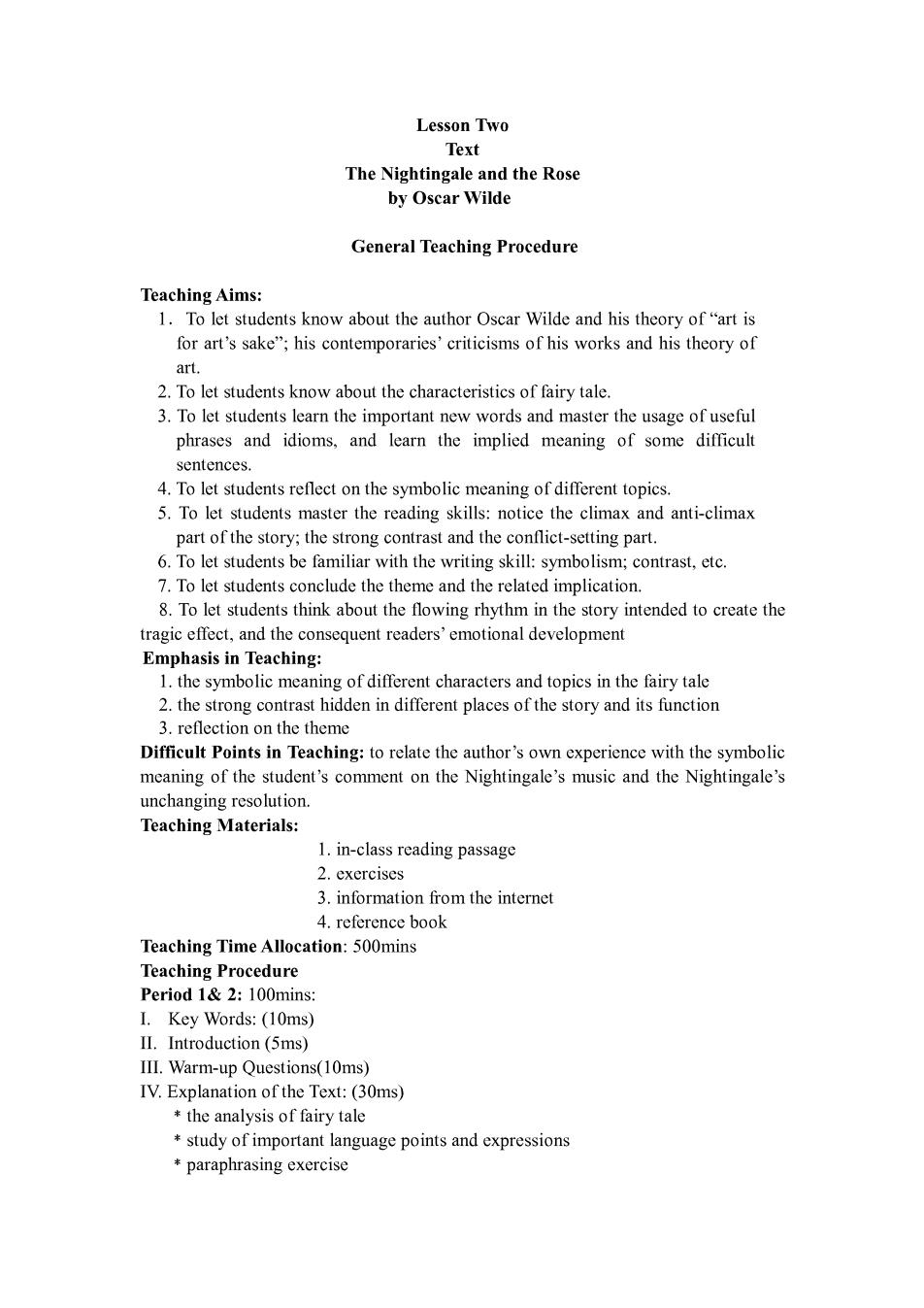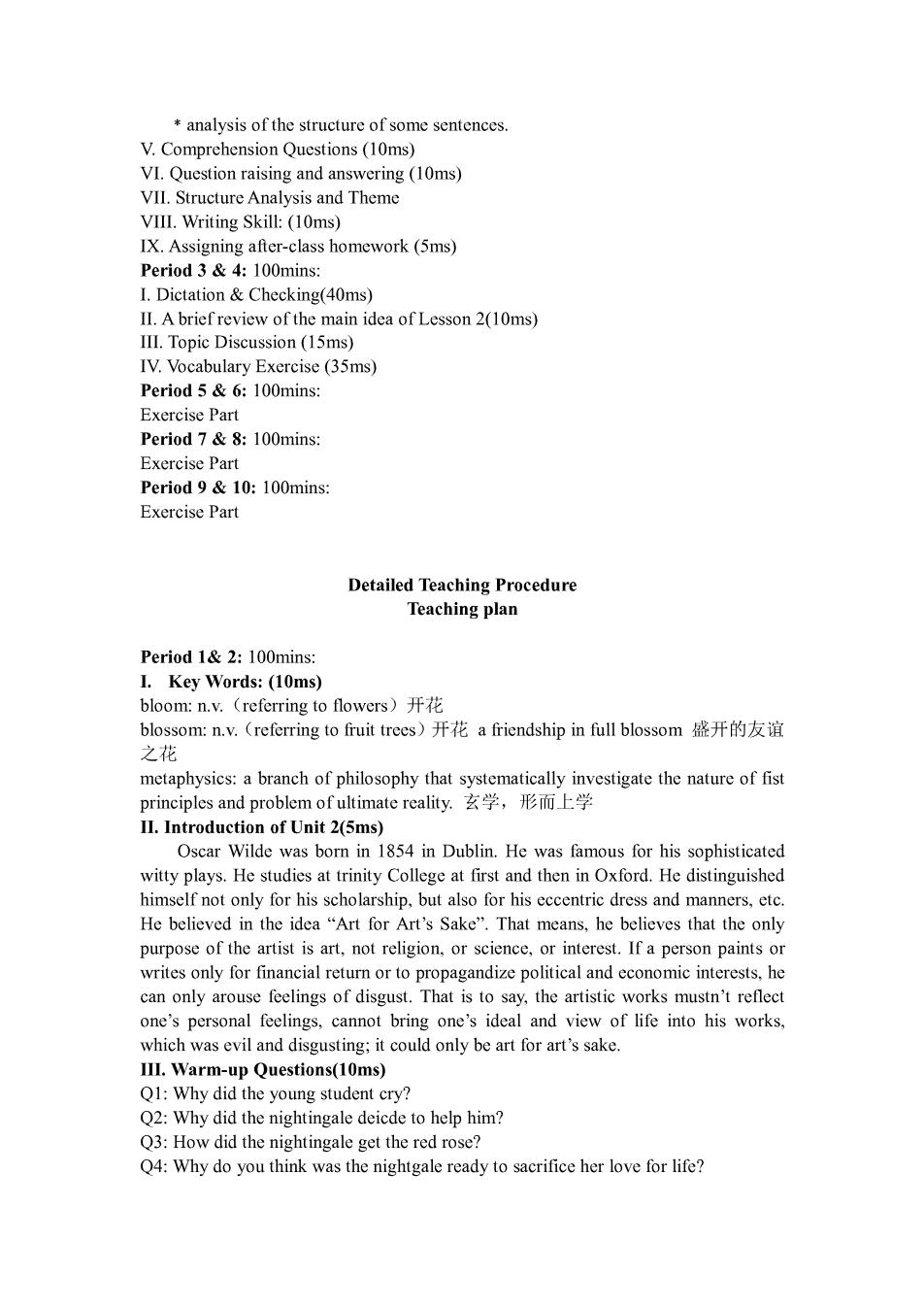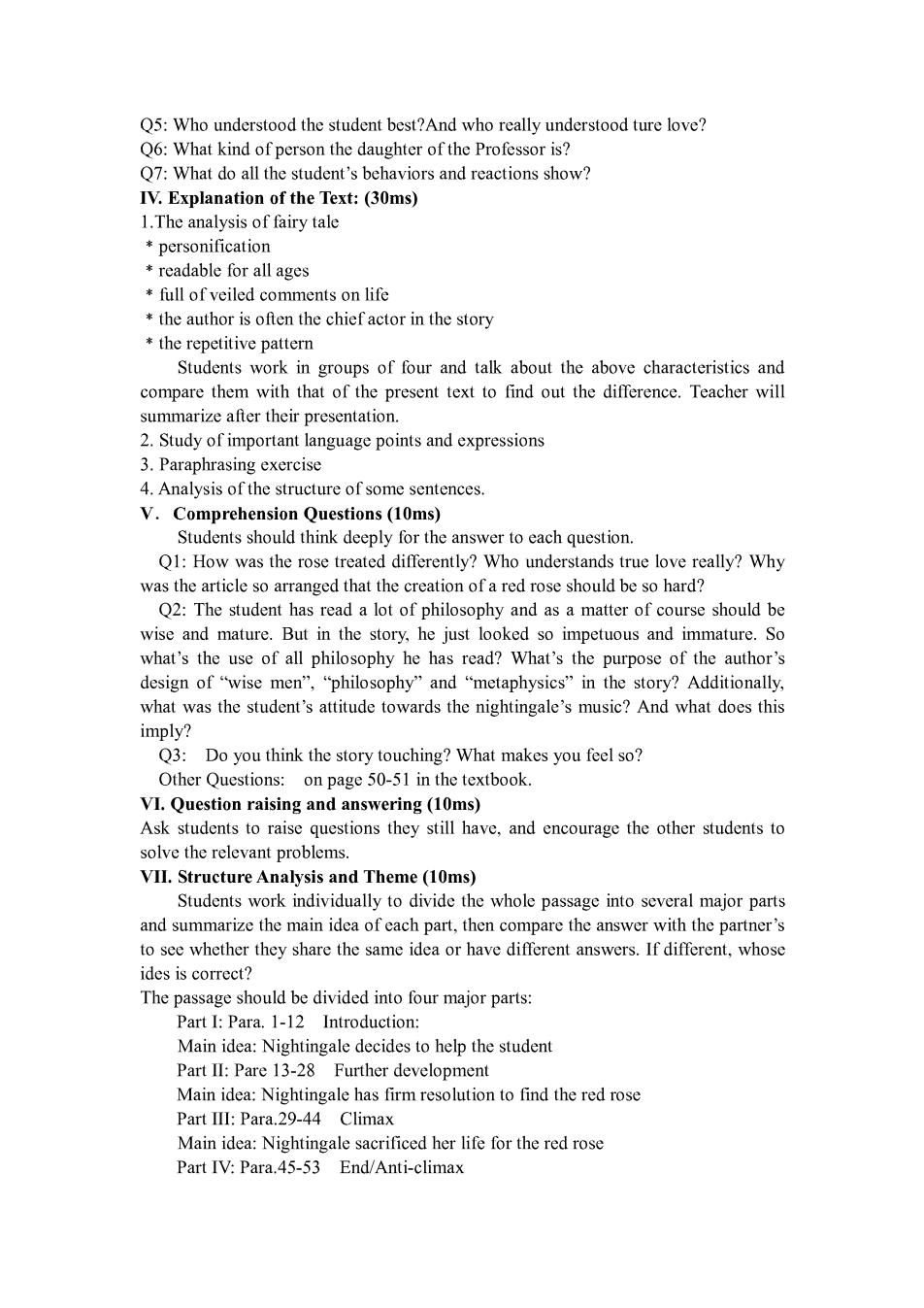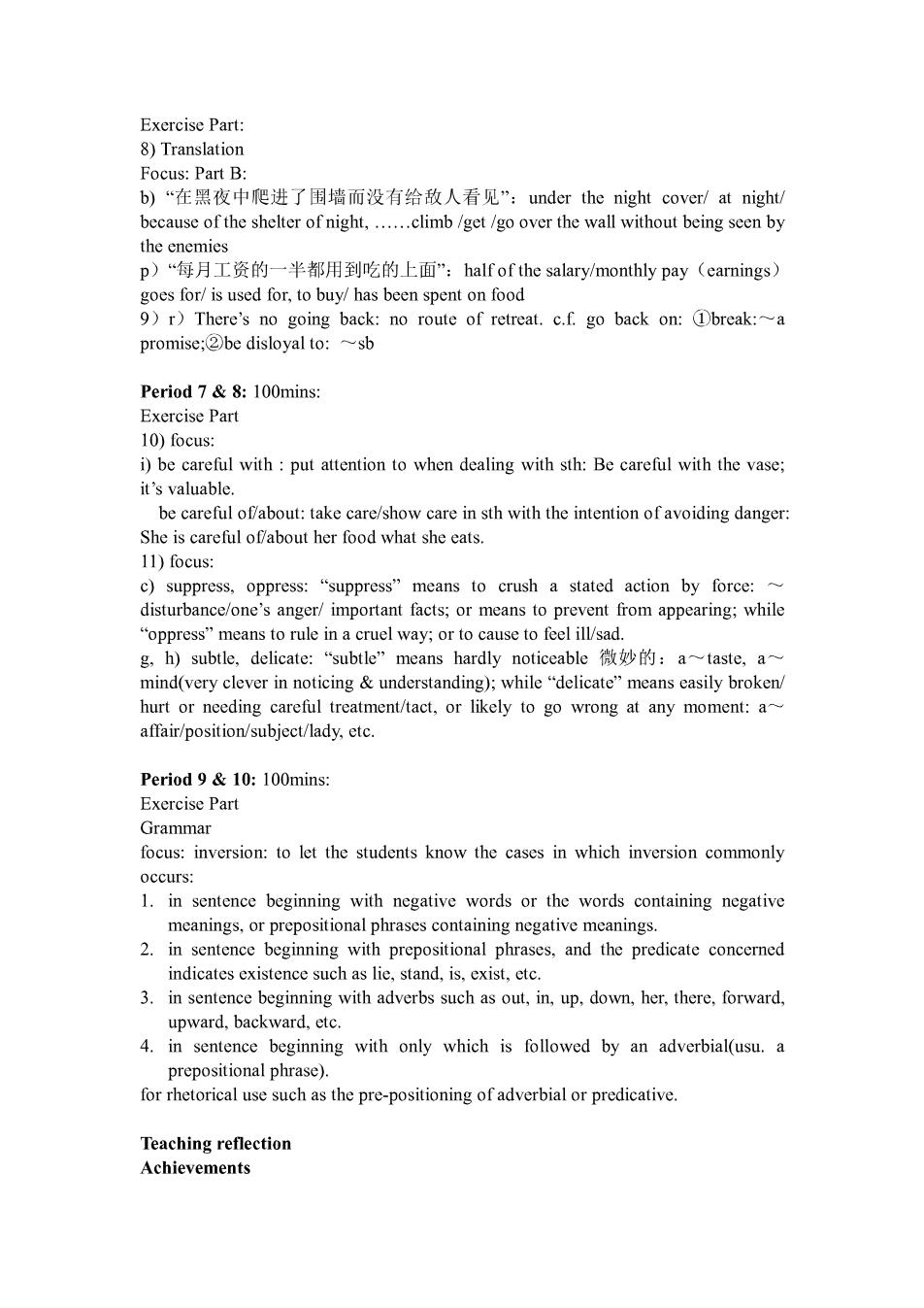
Lesson Two Text The Nightingale and the Rose by Oscar Wilde General Teaching Procedure Teaching Aims: 1.To let students know about the author Oscar Wilde and his theory of"art is for art's sake";his contemporaries'criticisms of his works and his theory of art 2.To let students know about the characteristics of fairy tale 3.To let students learn the important ew words and master the usage of useful phrases and idioms,and learn the implied meaning of some difficul sentences. 4.To let students reflect on the symbolic meaning of different topics. 5.To let students master the reading skills:notice the climax and anti-climax strong st and the onfict-setting part. wth thewitng ymbo onrat ete 7.To let students conclude the theme and the related implication. 8.To let students think about the flowing rhythm in the story intended to create the tragic effect.and the consequent readers'emotional development Emphasis in Teaching: the symbolic me tale 2.the strong cont reflection on the theme Difficult Points in Teaching:to relate the author's own experience with the symbolic meaning of the student's comment on the Nightingale's music and the Nightingale's unchanging resolution. Teaching Materials 1.in-class reading passage 2.exercises 3.information from the internet 4.reference book Teaching Time Allocation:500mins Teaching D I.Key Words:(10ms) II.Introduction(5ms) III.Warm-up Questions(10ms) IV.Explanation of the Text:(30ms) the analysis of fairy tale +study of important language points and expressions *paraphrasing exercise

analysis of the structure of some sentences. VI.Question raising and answering(10ms VII.Structure Analysis and Theme VIII.Writing Skill:(10ms) IX Assigning after-class homework (5ms) Period 3 4:100mins: I.Dictation&Checking(40ms) II.A briefreview of the main idea of Lesson 2(10ms) III.Topic Discussion(15ms) IV.Vocabulary Exercise(35ms) Period 5&6:100mins: Exercise part Period7:100mins: Exercise Par Period 9 10:100mins: Exercise Part Detailed Teaching Procedure Teaching plan Period 1&2:100mins: I.Key Words:(10ms) bloom:n.v. (refe ming oflowers)开花 blossom:n...(referring to fruit trees)开花a friendship in full blossom盛开的友谊 之花 metaphysics:a branch of philosophy that systematically investigate the nature of fist principles and problem ofultimate reality..玄学,形而上学 on of Unit 2(5ms Oscar ilde was born in 1854 in Dublin.He was famous for his sophisticated witty plays.He studies at trinity College at first and then in Oxford.He distinguished himself not only for his scholarship,but also for his eccentrie dress and manners,ete. He believed in the idea "Art for Art's Sake".That means,he believes that the only Ifa person paintso can only arouse feelings of disgust.That is to say,the artistic works mustn't reflect one's personal feelings,cannot bring one's ideal and view of life into his works. which was evil and disgusting;it could only be art for art's sake. III.Warm-up Questions(10ms) 01:Wh did th e young stude cry Q2:Why did the nightingale deicde to help him? Q3:How did the nightingale get the red rose? Q4:Why do you think was the nightgale ready to sacrifice her love for life?

05:Who understood the student best?And who really understood ture love? or is? IV.Explanation of the Text:(30ms) 1.The analysis of fairy tale personification .rcadable for all age *full of veiled omments on life the author is often the chief actor in the story the repetitive pattern Students work in groups of four and talk about the above characteristics and compare them with that of the present text to find out the difference.Teacher will 2.Study of important language points and expressions 3.Paraphrasing exercise 4.Analysis of the structure of some sentences. V.Comprehension Questions(10ms) sho uld think de eply for the ar r to each question Who understands true love really?Why was the article so arranged that the creation of a red rose should be so hard? Q2:The student has read a lot of philosophy and as a matter of course should be wise and mature.But in the story,he just looked so impetuous and immature.So what's the use of all philosophy he has read?What's the purpose of the author's design of"wise men ”andn etaphysics”inth e story?A ddit onally what was the student's attitude towards the nightingale's music?And what does this imply? Q3:Do you think the story touching?What makes you feel so? Other Questions:on page 50-51 in the textbook. VI.Question raising and answering(10ms) Ask students to raise questions they still have,and encourage the other students to solve the relevant problems. VII.Structure Analysis and Theme(10ms) Students work individually to divide the whole passage into several maior parts and main idea of each are the answer wth the partner' tosee whether they share the same idea or have different answers.If different,whosc ides is correct? The passage should be divided into four major parts: Part I Para 1-12 Introduction: Main idea:nightingale decides to help the student Part II:Pare 13-28 Further development Main idea:Nightingale has firm resolution to find the red rose Part IIl:Para.29-44 Climax Main idea:Nightingale sacrificed her life for the red rose Part IV:Para.45-53 End/Anti-climax

Main idea:The student discards the precious flower. Theme:True ove is hard to hunt down,and once you possess it you must treasure it for it is more precious than life Implication: In spite of other's misunderstanding.even contempt,one's pursuit of truth/belief shouldn't cease/be changed. VIII.Writing Skill:(10ms) 1.svmbolism among Lizard Butterfly and Daisy;the student's comment on the Nightingale's music:the Nightingale's unchanging resolution and understanding of true love:use of heavy books,“wise men”,"philosophy,and"metaphysics”,ctc. 2.contrast and its effect contrast between Nightingale's valuing rue love and Student's indifference true love:between the death of Nightingale and the creation of the red rose;betweer Nightingale's unchanging resolution and Student's changeable mind:between Nightingale's understanding and Student's misunderstanding;between the vain sacrifice and the preciousness of life;between the student's seeming knowledgeable and his immaturity and recklessness;between Nightingale's gr ess and Student's selfishness,et effect:arouse the reader's sympathy:create the moving and instructive effect IX.Assigning After-class Homework(5ms) 1.Review what they have learned in this class; 2.Do Exercises of the first part(explanation,idioms and phrases,analysis). Period 3 4:100mins: I.Dictation Checking(40ms) A.Words B.Translation of Phrases 工Aa5 ng vith Phr in idea of Lesson 2(10ms) Ask a student to retell III.Topic Discussion (15ms) Comment on people's"practical"concerns in relation to love. IV.Vocabulary Exercise (35ms) Vocabulary: 5)focus:adjending with"ic"and"ical"may have differ rent meani ings.e.g. economic:concerning economy/economics;economical:frugal,be careful in using money,cheap and practical politic:concerning politics;political:wise and considerate,cunny 8)A)focus:举行宴会:hold/give/have a banquet,feast,big dinner,etc. 以手遮面: cover/bury one's face in one's hands Period 5 6:100mins:

Exercise Part: 8)Translation Focus:Par b)“在黑夜中爬进了围墙而没有给敌人看见”:under the night cover/,at night/ because of the shelter of night,......climb/get /go over the wall without being seen by the enemies p)“每月工资的一半都用到吃的上面":half of the salary/monthly pay(carnings) goes for/is used for.to buy/has been spent on food 9)r)There's no going back:no route of retreat.c.f.go back on:Dbreak:~a promise:2be disloyal to:~sb Period 7&8:100mins: 10)locus i)be careful with put attention to when dealing with sth:Be careful with the vase: it's valuable. be careful ofabout:take care/show care in sth with the intention of avoiding danger: She is careful ofabout her food what she eats 11)focus c)suppress,oppress:"suppress"means to crush a stated action by force: disturbance/one's anger/important facts;or means to prevent from appearing;while "oppress"means to rule in a cruel way;or to cause to feel ill/sad. h)subtle.delicate:m ans hardly noticeable微妙的:a~taste,a~ mind(very clever in noticing&understanding):while"elicate"means easily broken hurt or needing careful treatment/tact,or likely to go wrong at any moment:a~ affair/position/subject/lady,etc. Period 9&10:100mins Exercise Part Grammar focus:inversion:to let the students know the cases in which inversion commonly occurs: 1.in sentence beginning with negative words or the words containing negative mcanings ositional phr ntai negative 2. in sentence eginning with prepositional phrases,and the predicate concerned indicates existence such as lie,stand,is,exist,ctc 3.in sentence beginning with adverbs such as out,in,up,down,her,there,forward, upward,backward.etc. 4.in sentence beginning with only which is followed by an adverbial(usu.a prep tional phrase) for rhetorical use such as the pre-positioning of adverbial or predicative. Teaching reflection Achievements